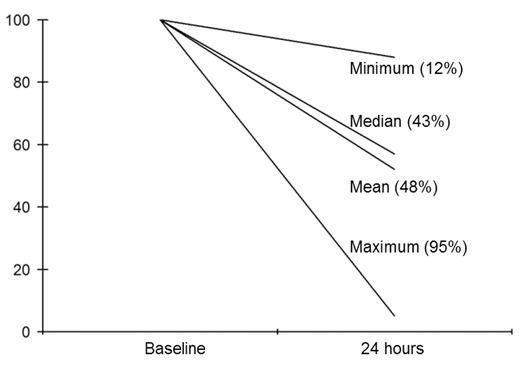Abstract
Hyperuricemia is a commonly seen in patients with hematologic malignancies and high tumor burden, and is a major feature of tumor lysis syndrome (TLS). Hyperuricemia is conventionally treated with hydration, urine alkalinization, and allopurinol. Allopurinol inhibits the conversion of hypoxanthine to xanthine, and xanthine to uric acid (UA) by inhibiting xanthine oxidase. It has no direct effect on existing UA in the serum. Rasburicase lowers UA rapidly to very low levels at the approved dose of 0.15–0.2 mg/kg daily for 5 days by converting UA to allantoin which is excreted rapidly. Despite this dramatic effect on UA, rasburicase has not been shown to have any beneficial impact on survival in patients with hematologic malignancies. We administered 0.2 mg/kg ideal body weight rasburicase to an obese hyperuricemic patient (actual 120 kg, ideal 60 kg). Serum UA declined from 11 mg/dL to 1.4 mg/dL in 3 h and 0.4 mg/dL in 11 h. The serum UA level remained low for several days and a second dose was not needed. After seeing this dramatic and sustained response, variable low rasburicase doses were used in patients with malignant diseases with close monitoring of biochemical parameters (Trifilio et al, ASH 2004). Here, we present our experince with the use of a single 3 mg dose of rasburicase in 42 adult patients receiving chemotherapy or undergoing hematopoietic stem cell transplantation for hematologic malignancies. In addition to rasburicase, allopurinol and other supportive therapy including hydration were also administered. Serum UA levels (baseline 6.4–16.4 mg/dL, median 9.7) had declined by 12–95% (median 43%) 24 hours after rasburicase administration.
The baseline serum creatinine was 1.0–8.6 mg/dL (median 2.1), and that 24 hours after rasburicase administration was 0.7–8.0 mg/dL (median 2). The median change in creatinine was a decline of 10%. Except for 3 myeloma patients who were already on chronic hemodialysis, renal impairment did not progress to hemodialysis in any patient - and substantial renal function improvement (at least 50% decline in serum creatinine) was seen in all patients with a baseline serum creatinine of ≥ 3 mg/dL. Based on the Red Book rasburicase cost of $387 for a 1.5 mg vial, the amount of money saved ranged from ~$10,000 to ~$30,000 per patient. Our data suggest that rasburicase is effective at a fraction of the recommended dose. A formal randomized comparison of low- and conventional-dose rasburicase is warranted to see if the recommended higher dose offers any clinical benefit.
Author notes
Corresponding author


This feature is available to Subscribers Only
Sign In or Create an Account Close Modal